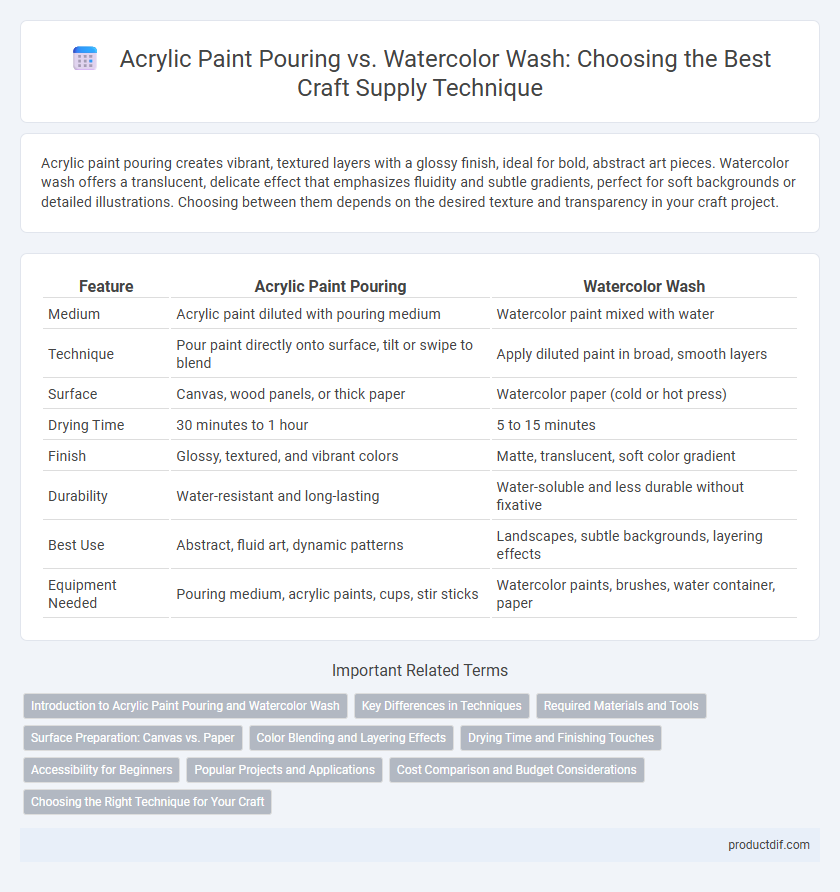Acrylic paint pouring creates vibrant, textured layers with a glossy finish, ideal for bold, abstract art pieces. Watercolor wash offers a translucent, delicate effect that emphasizes fluidity and subtle gradients, perfect for soft backgrounds or detailed illustrations. Choosing between them depends on the desired texture and transparency in your craft project.
Table of Comparison
| Feature | Acrylic Paint Pouring | Watercolor Wash |
|---|---|---|
| Medium | Acrylic paint diluted with pouring medium | Watercolor paint mixed with water |
| Technique | Pour paint directly onto surface, tilt or swipe to blend | Apply diluted paint in broad, smooth layers |
| Surface | Canvas, wood panels, or thick paper | Watercolor paper (cold or hot press) |
| Drying Time | 30 minutes to 1 hour | 5 to 15 minutes |
| Finish | Glossy, textured, and vibrant colors | Matte, translucent, soft color gradient |
| Durability | Water-resistant and long-lasting | Water-soluble and less durable without fixative |
| Best Use | Abstract, fluid art, dynamic patterns | Landscapes, subtle backgrounds, layering effects |
| Equipment Needed | Pouring medium, acrylic paints, cups, stir sticks | Watercolor paints, brushes, water container, paper |
Introduction to Acrylic Paint Pouring and Watercolor Wash
Acrylic paint pouring involves mixing acrylic paints with a pouring medium to create fluid, abstract designs that emphasize vibrant colors and dynamic patterns. Watercolor wash uses diluted watercolor pigments applied in translucent layers, producing soft gradients and subtle color transitions ideal for delicate, atmospheric effects. Both techniques offer unique textural qualities and visual impacts, with acrylic pouring favoring bold, spontaneous compositions and watercolor wash emphasizing controlled, ethereal backgrounds.
Key Differences in Techniques
Acrylic paint pouring involves mixing acrylic paints with pouring medium to create fluid, vibrant layers that flow and blend on a canvas, producing abstract, marbled effects. In contrast, watercolor wash relies on diluting pigments with water, allowing for transparent, soft gradients and subtle color transitions typically applied in thin, even layers. The main difference lies in the mediums' viscosity and drying properties, with acrylic pouring creating textured, glossy surfaces while watercolor washes result in delicate, matte finishes.
Required Materials and Tools
Acrylic paint pouring requires fluid acrylic paints, pouring medium, silicone oil for cells, disposable cups, stirring sticks, and a level surface for curing. In contrast, watercolor wash demands watercolor paints, brushes (typically round or flat), water containers, watercolor paper, and masking tape to control edges. Both techniques benefit from protective coverings like drop cloths to keep workspaces clean.
Surface Preparation: Canvas vs. Paper
Acrylic paint pouring requires primed canvas surfaces to prevent paint absorption and ensure vibrant color flow, while watercolor washes necessitate high-quality watercolor paper with appropriate texture and weight to absorb the pigment evenly without warping. Canvas offers durability and a textured base ideal for fluid acrylics, whereas watercolor paper's absorbency is critical for controlling pigment distribution and preventing blooms or hard edges. Proper surface preparation enhances paint adhesion and overall artwork durability, making the choice between canvas and paper key based on the painting technique used.
Color Blending and Layering Effects
Acrylic paint pouring creates vibrant, fluid color blending with dynamic swirls and seamless transitions, ideal for abstract, textured effects, while watercolor wash offers soft, translucent layers that build subtle gradients and gentle overlaps. The thickness and opacity of acrylic pouring enable distinct, bold layering without color muddying, whereas watercolor's transparency allows light to pass through each wash, producing luminous, ethereal layers. Choosing between the two depends on desired visual impact: acrylic pouring emphasizes intense, marbled blends, while watercolor wash favors delicate, airy color harmony.
Drying Time and Finishing Touches
Acrylic paint pouring typically dries within 24 to 48 hours, offering a glossy, textured finish that can be enhanced with varnish for added durability and shine. Watercolor washes dry much faster, often within 15 to 30 minutes, resulting in a translucent, matte finish that allows for subtle layering and delicate blending. Understanding these differences in drying time and finishing touches helps artists select the ideal medium for their desired visual effect and project timeline.
Accessibility for Beginners
Acrylic paint pouring offers beginners a hands-on, forgiving technique with minimal tools, making it easier to achieve vibrant, fluid patterns without detailed brushwork. Watercolor wash requires more control over brush pressure, water-to-pigment ratio, and timing, presenting a steeper learning curve for novices. Craft supply kits for acrylic pouring often include premixed paints and pouring mediums, enhancing accessibility and reducing setup complexity for new artists.
Popular Projects and Applications
Acrylic paint pouring is widely favored for creating vibrant, textured abstract art and fluid designs on canvases and wood panels, making it popular in home decor and personalized gifts. Watercolor wash excels in producing soft, translucent backgrounds and delicate gradients, often used in botanical illustrations, card making, and scrapbooking projects. Both techniques cater to different artistic styles and project needs, enhancing the versatility of craft supplies for hobbyists and professionals alike.
Cost Comparison and Budget Considerations
Acrylic paint pouring typically requires a higher initial investment due to the cost of specialty pouring mediums, silicone oils, and quality acrylic paints, which often range from $10 to $30 per tube. In contrast, watercolor wash supplies--such as watercolor pans, brushes, and minimal paper--are generally more affordable, with sets often priced between $5 and $15. Budget-conscious crafters should weigh the ongoing expenses of replenishing acrylic mediums against the lower maintenance costs of watercolor materials for long-term savings.
Choosing the Right Technique for Your Craft
Acrylic paint pouring creates vibrant, textured effects with thick, glossy finishes ideal for abstract and fluid art projects, while watercolor wash offers soft, translucent layers perfect for delicate backgrounds and detailed line work. Consider the desired intensity, drying time, and surface compatibility when selecting between these techniques to achieve the best results in your craft. Acrylic pouring suits canvas and sturdy surfaces, whereas watercolor washes excel on paper and lightweight materials.
Acrylic Paint Pouring vs Watercolor Wash Infographic

 productdif.com
productdif.com